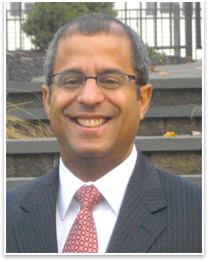 Robert Lopez Robert Lopez
by Russell Boniface
Associate Editor
Summary: Robert Lopez is executive secretary for the New York State Board for Architecture and the State Board for Landscape Architecture in Albany, N.Y. These boards assist and advise the state’s Board of Regents and Education Department in regulating 48 professions responsible for the health, safety, and welfare for New York citizens, which includes more than 15,000 architects residing both in and out of New York State.
Lopez left private practice as principal of an Albany firm to become executive secretary and has served in that capacity for nearly five years. He served on the AIA Continuing Education Quality Assurance Committee and is active on committees of the National Council of Architectural Registration Boards. Lopez talks about his role as executive secretary, design-build as a project delivery option in New York State, and a “typical day” on the job.
Executive secretary to protect the public; good practice, licensure
“Our office is housed within the New York State Education Department and our area is the Office of the Professions, which is unique being under the education arm of this government structure,” says Lopez. “There are times when the architect hat has to come off and I am here as a regulator of the profession.” New York law mandates that the executive secretary for the New York State Board for Architecture be a registered architect. Many jurisdictions in the country do not have that requirement.
Lopez’ office seeks to protect the health, safety, and welfare of New York’s citizens through high standards of professional licensure. Lopez says a key role for his office is clarifying practice issues when an intern architect first comes in for licensure. “I think a lot of it is awareness,” he says. “We are working to get the word out about good practice.”
Lopez has visited the schools of architecture at Pratt, City College, and Cornell. “We lectured about what good practice is,” he says. “Some students’ eyes glaze over when they hear the word ‘practice’ but I hope parts of the lecture trigger an intern’s memory later. When you are in design studio, your first thought is design, perhaps not necessarily regulation of the profession. We try to tailor these conversations around what good design means, or what it means to put a seal on a document—try to make it real for the interns.”
Lopez is looking to social networking as a way to get the word out about good practice and the need for licensure. This includes Twitter, Facebook, and YouTube, as well as podcasts and Webinars. “We are looking at what technological ways are available to us within our budgetary constraints. Many architecture students leave their programs and never get licensed. You can either push information out to interns and architects or you can pull them in.” He provides an example: “By pushing out, our Web site has a lot of information. Pulling people in is if they look at the site as a resource.”
The design-build delivery issue
Lopez gave testimony last February 5 to the New York State Commission addressing design-build as an alternative project delivery system in New York State. Design-build is currently not a permitted practice in the state. Under design-build, both design and construction are contracted for with a general contractor, typically not a licensed design professional. New York State Board for Architecture research indicates that almost 20 states either do not permit design-build or allow it as a limited option, while 33 states permit design-build in some format.
In his testimony, Lopez addressed how appropriate checks and balances could be put in place if prohibitions against design-build were to be lifted.
“As a state employee, we are charged with public protection,” Lopez says. “There are numerous pros and cons to design-build. I have seen design-build projects that I have visited outside of the state where doorknobs were falling off because perhaps the contractor was trying to cut a corner and quality suffered. There were other design-build projects that have been good examples of decent design. We want to make sure that there isn’t a person between the architect and the building owner. With design-build you put the architect at times in awkward positions. If they are hired by the contractor, and the contractor is holding their check and holding the control and flow of money, it becomes difficult for the architect not to be influenced by that non-licensee. We want to make sure the architect has the dominion of control over the design of a project. That is the baseline we operate under. And that is why, I believe, design-build is not a permitted form of practice in New York.
“It is a very unlevel playing field in New York. There are architects who may be doing it. It has caught up in other issues. New York has looked at corporate practice as a whole and wants to examine it in a holistic approach, not pulling architecture out independently.”
A typical day
Lopez says a typical day for him might involve speaking to attorneys or architects to clarify practice issues. “We deal with architects who knowingly or unknowingly formed an incorrect form of practice, such as forming a general business corporation instead of a permitted form of practice. We deal with potential illegal practice and practices where an architect and an interior designer have formed a business entity. In New York, there are no permissible corporate entities and recognized ways for an architect and an interior designer to form a partnership.” There also are disciplinary issues to address, he says, which include investigating complaints of misconduct that can lead to the prosecution of an architect.
He also leads an effort called “planting the seed” that collects data on how all the professions encourage young people in middle and high school to get into different professions. “It is one way the Office of Professions can connect to the State Education Department,” he says.
|



